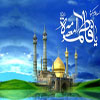
Speaker of Ahlul Bayt's (A.S.) Virtues Fatima was the daughter of the seventh Imam, Musa Al-Kazim (A.S.). She was born on the 1st of Dhilqa'da, 173 A.H.. Prior to her birth, Imam Sadiq (a.s.) spoke of her status:
"Mecca is God's sanctuary, Medina is Prophet Muhammad's (peace be upon him and his household), Kufa is Imam Ali's (A.S.), and Qom will be the sanctuary for one of my descendents; her name shall be Fatima. Whosoever visits her sanctuary will be rewarded a heavenly paradise."
Fatima represented the purity and infallibility of Prophet Muhammad's daughter, Fatima tul-Zahra (A.S.), and demonstrated the courage and determination of Zeinab (A.S.), daughter of Imam Ali (A.S.) Advocation for her brother Imam Ali bin Moosa Al- Rida (A.S.) and upholding the virtues of Ahlul Bait has established her as a noble lady in the history of Shia"ism. It was this support that guided her emigration, for which she is renown.
Imam Ali bin Moosa Al- Rida (A.S.) was forced to emigrate from Medina to Khurasan in 200 A.H by the ruling Abbasid caliph Mamun. A year later, 201 A.H., Fatimah decided to join him to maintain and protect the high, fruitful, and lofty tree of Prophet Muhammad (peace be upon him and his household). Before preparing to leave, she visited the tomb of Prophet Muhammad (peace be upon him and his household) and other Imams buried at Baqi" cemetery to say farewell, as her infallible brother, Imam Rida (A.S.) had done the previous year. At that time she was 28 years old.
Leaving Medina, the homeland of her reverent family, was difficult. This emigration aroused feelings of grief and oppression for her family. Sorrow pervaded her soul in memory of other members of Ahlul Bayt who emigrated to escape persecution or who were forcibly expelled. Now, she too had become an emigrant. She departed from Medina with tears of grief and anguish. In spite of the melancholy mood, Fatimah, accompanied by her brothers and nephews, organized the caravans earnestly with great eagerness to join her brother (A.S.) in Khurasan, Iran. That reunion could compensate for the hardship of emigration and the bitterness of separation from their homeland.
When in route, and passing by Saweh, the caravan was attacked by plunders of the Bani Al-Abbas tribe. Twenty three members of the Ahlul Bayt were martyred. Fatima encountered a new catastrophe and a new tragedy. It resembled the plight of Zainab (A.S.). Facing these kinds of oppression by the enemies of Ahlul Bayt were unbearable. Suddenly, Fatimah became ill by this great shock. Despite this brutal attack, the remaining survivors in the caravan continued marching and approached the city of Qom, where Fatimah was received an honourable welcome. She was invited to stay in the city as a respected guest among the Shi"a community of the city.
Sadly, her sojourn met with grief. The encounter inflicted upon the caravan near Saweh was overwhelming. Seventeen days after her arrival on the 10th of Rabee-us-Thani, 201A.H., she died.
Sorrow pervaded the Shi"a community. Obsequies were gloriously held for Fatimah and her tomb was embellished with a dome. Musa bin Khazraj's house, where she had sojourned, was converted to the school of Sittiyah. Her mihrab was called "The Brilliant House".
Imam Rida (A.S.) said: "Her visitors shall be endowed with paradise" and "Whosoever visits the sanctuary of Fatimah, will be rewarded a heavenly paradise".
It should be mentioned that Imam Jawad's (A.S.) daughters, Zaynab, Meymonah and Umm Muhammad, were also buried in Fatimah's tomb.
Her seventeen days of sojourning in Qom gave an historical reason for this city to be the center of Shi"a theological studies. Many scholars and jurisprudents have resided in the city near her sanctuary such as, Zekariya bin Adam {one of the companions of Imam Rida (A.S.)}, Ahmed bin Isaac {one of the representatives of Imam Hasan Al-Askari (A.S.)} who was confirmed by Imam Al-Mehdi (A.S.), Mirza Qommi, Ayatullah Sayed Mohammed Khunsari, Ayatullah Hujjat, Ayatullah Burujerdi, Ayatullah Golpaygani, Ayatullah Mar"ashi Najafi, Ayatullah Sadr, Ayatullah Araki, Ayatullah Sayed Ahmed Khunsari, Allama Tabataba"i, Ayatullah Mutahhari, and Imam Khomeini.
The continuity of producing grand scholars in the world of Shi"aism is one of the blessings of Fatimah"s spiritual presence. She gave Qom its central place in the Islamic world. Besides Shi"ites, Hanafi and Shafi"e scholars have also visited the city from time to time to acquire more knowledge.
Eventually, the Islamic Revolution in Iran, which is wisely led by the Islamic jurisprudential guardians, specifically the leader of the Islamic world, Ayatullah Sayed Khameni's (may his presence be protected) is the fruit of this holy city and the blessing of the Grand Faiziya School.
source : www.abna.ir













